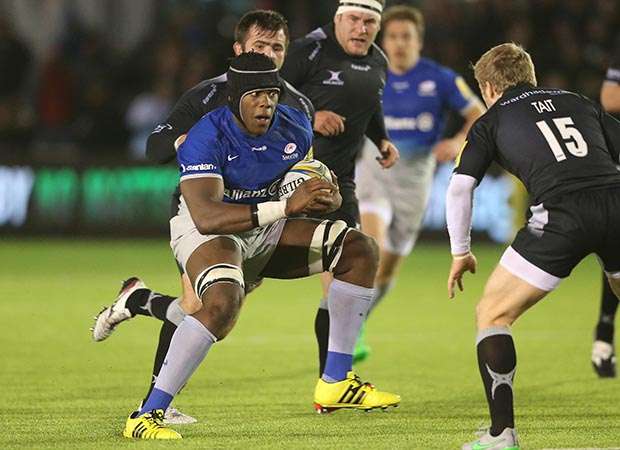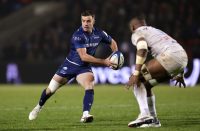 Eddie Jones may have stepped into the Twickenham tunnel with his eyes wide open, but already he is having to negotiate his way through a labyrinth full of fog. The densest cloud of the stuff surrounds the selection of the EPS and Saxons squads, with England‘s new Australian head coach having to select an elite group of 65 players by January 13.
Eddie Jones may have stepped into the Twickenham tunnel with his eyes wide open, but already he is having to negotiate his way through a labyrinth full of fog. The densest cloud of the stuff surrounds the selection of the EPS and Saxons squads, with England‘s new Australian head coach having to select an elite group of 65 players by January 13.
Jones has inherited a 33-strong senior EPS squad from the 2015 World Cup (31 plus non-playing reserves Luther Burrell and Calum Clark) – picked by his predecessor, Stuart Lancaster – and has a 32-man Saxons reserve to name.
Under the terms of the existing agreement between the RFU and the PRL, Jones is not allowed to change any more than 30 percent of the EPS squad, although following the return of Sam Burgess to Rugby League, and injury to Henry Slade, that figure could increase to 12 changes.
Whether this gives Jones the leeway for a full clean-out of the senior squad, should he decide on that course of action, is subject to multiple sub-clauses, many of which will centre on the movement allowed between the EPS and Saxons contingents.
This grey area explains why this week RFU and PRL sources both suggested to me that it is inconceivable that Jones would want to make 12 changes, let alone more.
Yet, a sacrosanct principle of elite sport is that no new coach should be hamstrung by the selections of his predecessor. What if Jones has arrived at the view that many of England’s senior World Cup forwards had been given ample opportunities over the last four years and been found wanting?
After a World Cup debacle which was based squarely on England’s deficiencies up front he would find few arguments for retaining the EPS status quo from this quarter, and if Jones wants to build a new pack it is entirely plausible he could switch as many as 11 or 12 forwards – which would use up his entire ‘change’ quota.
There is no doubt in my mind that the new coach would be well-advised to consider wholesale changes in the England pack because of serious flaws in every row of the scrum which became embedded on Lancaster’s watch, and came home to roost during the tournament.
Too many of the front-row forwards lacked the peak physical conditioning of their counterparts in the elite Southern Hemisphere sides. Not only did they look stodgy by comparison, they played stodgy, failing to bring aggression and drive to the set-piece or the loose.
By now Jones will be aware that there is an aggressive new generation of loose-heads with Nick Auterac (Bath) and Alex Waller (Northampton) in the vanguard, which means that while Mako Vunipola may survive in the front rank, Joe Marler, who misfired badly in the World Cup crunch against the Wallabies, could slip down the pecking order. The same applies at tight-head, where Kieran Brookes, Henry Thomas and Jake Cooper-Woolley have made a case already for supplanting Dan Cole and David Wilson.
At hooker the inability, or unwillingness, of many leading Premiership hookers to adapt from their all-out reliance on pushing by learning to strike for the ball is another significant shortfall in the English game. Tom Youngs has made his reluctance to hook known on more than one occasion, and Rob Webber (Bath) is of a similar ilk, as is his club rival Ross Batty.
This goes a long way to explaining why during the recent Leicester v Bath encounter at Welford Road the scrum collapsed 17 times, often with the ball stuck in the tunnel and neither side able to produce the quick, clean ball needed to use it as an attacking platform.
If you are looking for a reason for England’s scrummaging deficiencies in the World Cup then look no further than the one-dimensional Premiership fixation, shared by England, of pushing other teams off the ball – with no plan B if it doesn’t work. For the record, it failed to work not only against Australia, but also against Fiji.
The most effective alternative is a quick strike by the hooker which whips the ball to the feet of the No.8, and it is something that the new brigade in the shape of Jamie George (Saracens), Mike Haywood (Northampton) and Dave Ward (Harlequins) can deliver.
 Another reason England’s pack lacked close-quarter clout both at the scrum and in the driving mauls is because Lancaster and his forwards coach, Graham Rowntree, decided that the mobility offered by Courtney Lawes and Geoff Parling, two lighter locks, was paramount. As a result, a big combine-harvester lock like Dave Attwood was discarded, with undue emphasis put on occasional lapses in concentration rather than the physical power he injected.
Another reason England’s pack lacked close-quarter clout both at the scrum and in the driving mauls is because Lancaster and his forwards coach, Graham Rowntree, decided that the mobility offered by Courtney Lawes and Geoff Parling, two lighter locks, was paramount. As a result, a big combine-harvester lock like Dave Attwood was discarded, with undue emphasis put on occasional lapses in concentration rather than the physical power he injected.
Ed Slater, another lock who is feisty in the hand-to-hand combat, was scuppered by a knee injury last season, but even so the indicators were that he had even less chance of breaking into the inner sanctum than Attwood.
However, Lawes and Parling were so muted during the World Cup that their automatic presence in the England line-up under Rowntree should now have run its course. Lawes was invalided out of the World Cup at half-time against Wales, but at no point either in the build-up, or in the tournament itself, did he approach the world-class standards he is capable of.
Likewise, Parling did not come close to playing with the authority he showed for Exeter against Wasps last weekend, with the late lineout call against Wales symptomatic of the rudderless state of the England set-piece and driving maul.
The idea that Joe Launchbury is suddenly the panacea to all England’s front five and captaincy ills is also flush with wishful thinking. Launchbury remains a promising lock who should be in the mix, but he is no towering presence as a lineout or re-start operator, and until those areas are as impressive as his work in the loose sometimes is, he is not assured of a place.
At the moment Launchbury faces stern competition from George Kruis – the Saracens workaholic whose aerial work is sharper – not to mention Attwood, Slater and Graham Kitchener, who has emerged as a genuine athlete-lock.
If second row was a perceived strength which ended up as a World Cup mirage, then at least Lancaster had plenty of notice before the tournament that his backrow was seriously short of pace and ball-winning capacity compared to Wales and Australia, let alone New Zealand, South Africa and Argentina.
He ignored it. Instead, he listened to Harlequins rugby director Conor O’Shea, and others, who for three seasons touted Chris Robshaw as an openside of the calibre of Richie McCaw and David Pocock, despite his lack of pace and ingrained ball-winning technique. A more balanced appraisal would have been to recognise him as an accomplished blindside with international credentials, which is how his early Quins mentor, Dean Richards, described him.
England’s lack of quick ball or turnovers at the World Cup proved that McCaw, Pocock, Michael Hooper and Francois Louw were in a different league so conclusively that O’Shea – having championed Robshaw’s openside cause relentlessly – has subsequently done an about-turn by playing him at blindside since his return to the Stoop.
Robshaw has been effective enough for his club at 6 that O’Shea is now advocating that he continue as England captain. This would push Tom Wood, his long-standing rival for the leadership during Lancaster’s tenure, out of the line-up at blindside.
It would also sideline the even more experienced James Haskell.
There is a strong case, however, for a complete revamp, with neither Robshaw nor Wood in the starting 23. This is because as long as a big units like Billy Vunipola, Ben Morgan – or evergreen oldies like Thomas Waldrom or Nick Easter – are at No.8, England need speed and dynamism at flanker, whether blindside or openside.
Those are not the stock in trade of Robshaw or Wood. However, they are ingredients that big athletes like the Saracens meteor Maro Itoje (who also plays lock), Sale’s towering Josh Beaumont, above, Harlequins all-rounder Jack
 Clifford, above,, or Exeter’s young powerhouse Dave Ewers – all of whom have played 6 and 8 – could bring to the blindside role. What is certain is that Jones does not lack alternatives.
Clifford, above,, or Exeter’s young powerhouse Dave Ewers – all of whom have played 6 and 8 – could bring to the blindside role. What is certain is that Jones does not lack alternatives.
Now that opensides are suddenly in vogue in England again – with their influence in the World Cup as great as we predicted long ago that they would be – there are four genuine contenders to replace Robshaw at 7.
The player who has been groomed longest is Matt Kvesic, and he’s learning his trade the hard way behind a Gloucester pack which is so up-and-down that the ride he gets is not so much armchair as carpet-burn. That may not be a bad thing because if Kvesic gets to play in a more accomplished Test outfit, the gritty work ethic he’s developed at club level should pay off.
If Will Fraser can finally get a lengthy injury-free run he could push Kvesic all the way. The Saracens openside is a rough-house who has the right instincts over the ball, and is a good link-man. Now, all he needs is game time.
The same can be said of Clifford, the 2013 England U20 captain and No.8 who has just signed a new Harlequins contract. He has an important call to make before he turns 23 in February. At the moment he is bouncing around the Quins back row, playing 6, 7 and sometimes 8.
At 6ft 3in Clifford is a couple of inches taller than Fraser and Kvesic, and, given his height, if he is going to compete for the openside shirt at the 2019 World Cup then he has to play in that position week-in week-out for four seasons, starting now, so that the angles, skill requirements and decision-making of a Test 7 become second nature.
Those attributes already appear to be hard-wired into Brendon O’Connor, the new Leicester openside. O’Connor is a Kiwi who qualifies for England through a grandmother, but he was schooled as a 7 in New Zealand. He appears to have all the hallmarks of a ball-winning ferret and good handling skills, but it is still early days for the former Auckland Blues flanker.
Given his grounding at No.8, Clifford has more options than O’Connor, Kvesic and Fraser. He could choose to concentrate on his old position, or blindside. Irrespective, like Pocock, who was a revelation in moving from openside to No.8 for the Wallabies in the World Cup, he should become a specialist first and a jack-of-all-trades second, not the other way round.
If Clifford opts for No.8 he will add to the ferocity of the competition for the Red Rose shirt after the World Cup no-show. At the moment Billy Vunipola has less ground to make up than Morgan, with the Gloucester man’s late run to make the World Cup squad after injury falling short in terms of fitness and form. Morgan looked short of full-throttle – as he does regularly for Gloucester – and although at his best he brings an attacking dynamism to the England backrow, it happens too sporadically.
When it comes to consistency and mobility the signs are that new challengers Nathan Hughes (Wasps) – who will be available to England via residency in July – and Beaumont, have an advantage. At 6ft 6in, the long-striding Beaumont also offers a clear lineout option, while so does the explosive Hughes, who is unrivalled in the Premiership as a carrier and inventive off-loader.
The trump card available to Jones as he mulls over how to construct an England pack with the world-beating calibre which confronted his 2003 Australia side, is that the Saxons is a selection reservoir. The Saxons may not have any fixtures arranged this season, but having a second squad means that if he wants to shake-up the pecking order among the Red Rose forwards he has the mechanism to do so.
All it requires for the fog to clear is to put a transfusion of new forward blood into the EPS, and to shunt a sizeable contingent of the World Cup pack into the Saxons.























